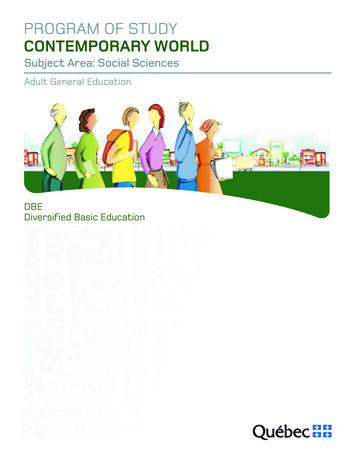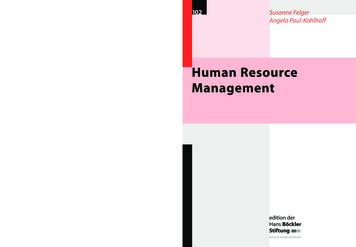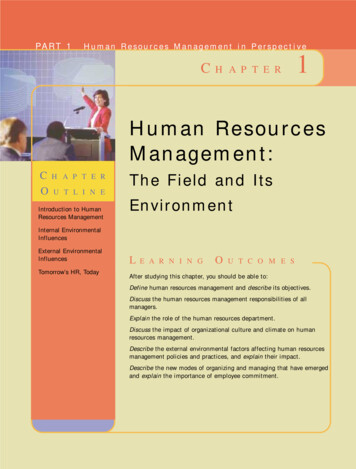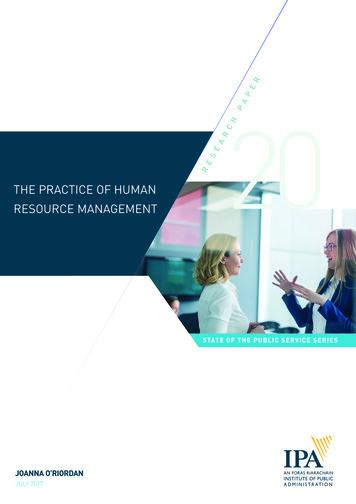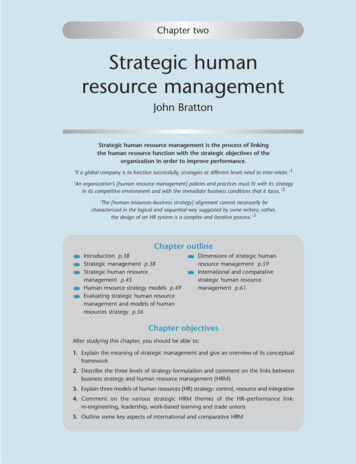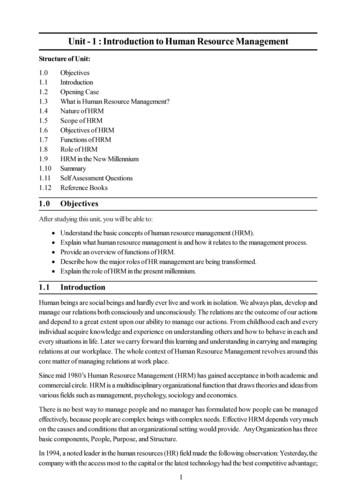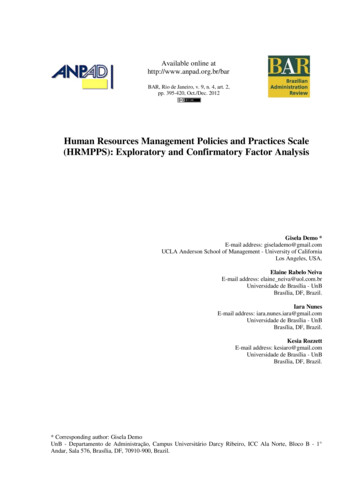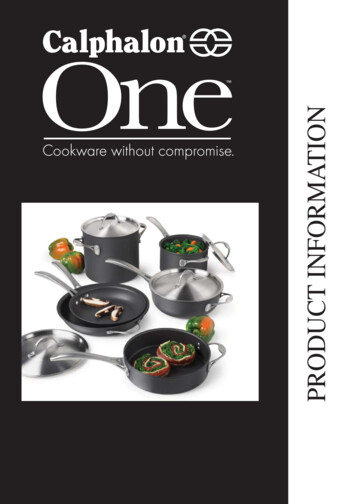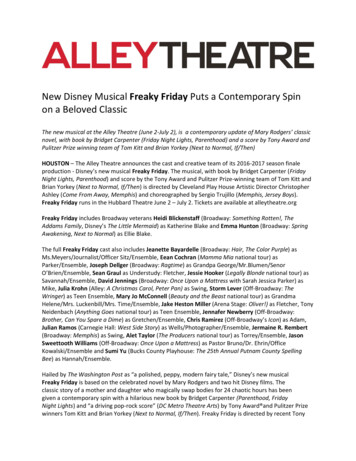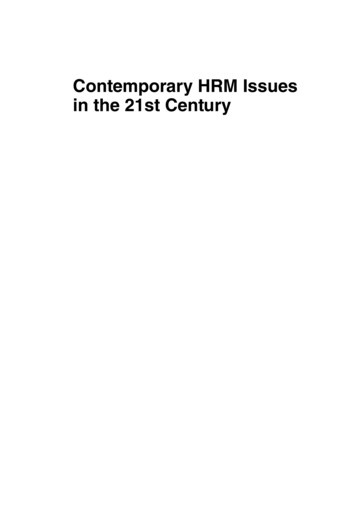
Transcription
Contemporary HRM Issuesin the 21st Century
Praise for Contemporary HRMIssues in the 21st Century‘This succinct, tightly written book moves beyond the ‘usual’ (and much covered) issues of standard HRM texts to address some of the livelier currentdebates on the subject. It includes talent management, career management, crisismanagement, mental health and well-being, drug testing, employee vetting andsustainable HRM. By updating knowledge on these contemporary issues, thisbook is a valuable addition to any scholar’s bookshelf.’Chris Brewster, Professor of International HRM,Henley Business School, University of Reading, UK‘This excellent book makes a valuable contribution to the broadly based HRMdiscipline in Australia. The author is clearly at the cutting edge of the development of HRM in Australia in the context of a growing Asia-Pacific economic area.I highly recommend this book for students, academics and HR practitioners.’Peter J. Dowling, Emeritus Professor of International Management & Strategy,La Trobe University, Melbourne, Australia
Contemporary HRM Issuesin the 21st CenturyEdited ByPeter HollandSwinburne Business School, AustraliaUnited Kingdom – North AmericaJapan – India – Malaysia – China
Emerald Publishing LimitedHoward House, Wagon Lane, Bingley BD16 1WA, UKFirst edition 2019Copyright 2019 Emerald Publishing LimitedReprints and permissions serviceContact: permissions@emeraldinsight.comNo part of this book may be reproduced, stored in a retrieval system, transmitted inany form or by any means electronic, mechanical, photocopying, recording orotherwise without either the prior written permission of the publisher or a licencepermitting restricted copying issued in the UK by The Copyright Licensing Agencyand in the USA by The Copyright Clearance Center. Any opinions expressed in thechapters are those of the authors. Whilst Emerald makes every effort to ensure thequality and accuracy of its content, Emerald makes no representation implied orotherwise, as to the chapters’ suitability and application and disclaims any warranties,express or implied, to their use.British Library Cataloguing in Publication DataA catalogue record for this book is available from the British LibraryISBN: 978-1-78973-460-7 (Print)ISBN: 978-1-78973-457-7 (Online)ISBN: 978-1-78973-459-1 (Epub)
ContentsLists of Figures and Tables viiAbout the Contributors ixPreface xiSection I: The Contemporary Workplace 1Chapter 1. HRM in the Contemporary WorkplacePeter Holland 3Chapter 2. Managing Talent: A ContemporaryIssue or a Case of Old Wine in New Bottles?Peter Holland 15Section I: Case Study 29Section II: Managing the Individual at Work 31Chapter 3. Psychological ContractsRoss Donohue and Tse Leng Tham 33Chapter 4. Career Management in the 21st CenturyRoss Donohue and Tse Leng Tham 51Chapter 5. HRM and the Service SectorCathy Sheehan 69Section II: Case Studies 81
viContemporary HRM Issues in the 21st CenturySection III: Managing the Issues at Work 87Chapter 6. Risk and Crisis ManagementCathy Sheehan 89Chapter 7. Mental Health and Well-being at WorkHannah Meacham, Jillian Cavanagh, Timothy Bartramand Katharina Spaeth 103Chapter 8. The Dark Side of WorkPeter Holland and Ross Donohue 117Section III: Case Studies 130Section IV: Emerging Issues at Work 135Chapter 9. To Test or Not to Test: Drug and GeneticTesting in the 21st Century WorkplacePeter Holland and Tse Leng Tham 137Chapter 10. Employer and Employee Vetting: ReputationManagement Challenges in the Information AgeDebora Jeske and Peter Holland 149Chapter 11. Sustainable HRM: Rhetoric Versus RealityRenee Paulet 159Chapter 12. Work Design in the 21st Century:A Case of Back to the Future or Forward to the Past?Peter Holland, Kirsteen Grant and Tse Leng Tham 173Chapter 13. Codes of Conduct: Are They Worththe Paper They Are Written On?Xiaoyan (Christiana) Liang and Peter Holland 183Index 197
Lists of Figures and TablesFiguresFigure 7.1.Productivity Costs per Country. 106Figure 8.1.The Costs of Workplace Violence. 124TablesTable 7.1. Percentage of Population Diagnosed with Depressionper Country. 105Table 7.2.HR Practices to Enhance Employee Resilience. 107Table 8.1.Expanded Typology of Workplace Violence. 118Table 8.2.Policy Development of Workplace Violence. 125Table 13.1. Evidence of Codes and Comparison of Code Content. 189Table 13.2. Attitudes Towards Codes at Times of Transgression. 191Table 13.3. Final Management Decision’s Consistency with Codes. 192vii
This page intentionally left blank
About the ContributorsTimothy BartramTimothy Bartram is a Professor of Management at RMIT University, Australia. Hisexpertise covers human resource management (HRM) and high-performance worksystems, employment relations, nursing management, workers with disability, Men’sSheds and Indigenous communities. Much of Tim’s research is multidisciplinary andpromotes the innovative use of HRM especially in the healthcare sector inclusive ofhospitals and healthcare industry.Jillian CavanaghJillian Cavanagh is a Senior Lecturer at RMIT. Her commitment to research is predominantly in the area of human resource management, employer support and the employment of workers with disabilities, men’s groups and sheds, community developmentand engagement, Aboriginal and Torres Strait Islander men’s health, and participationin men’s sheds.Ross DonohueRoss Donohue is an Associate Professor in the Department of Management at MonashUniversity. He has published in leading international journals such as the Journalof Vocational Behavior, Human Resource Development International and the Journal of Employment Counseling. He has also authored book chapters on careers andemployment.Kirsteen GrantKirsteen Grant is an Associate Professor of HRM at Edinburgh Napier University, UK.She draws on complementary backgrounds in organisational practice and academia.Her research interests centre on professional, responsible and precarious work; (changing) nature and expectations of work; talent management; workplace skills utilisation;and high-performance working.Peter HollandPeter Holland is a Professor of Human Resource Management and Director of theExecutive MBA at Swinburne University of Technology, Melbourne. His currentresearch interests include employee voice and silence, workplace electronic monitoring and surveillance and simulation-based learning. He has authored/co-authored12 books and over 120 journal articles, monographs and book chapters on a variety ofhuman resource management and employee relations issues.ix
xContemporary HRM Issues in the 21st CenturyDebora JeskeDebora Jeske is a Work and Organisational Psychologist in Berlin, Germany. Prior tothat, she worked as a lecturer at University College Cork in the Republic of Ireland.In her research, she combines her interest and knowledge of technology to understandwhich solutions work for individuals, teams and organisations.Xiaoyan (Christiana) LiangXiaoyan (Christiana) Liang is a Lecturer at Central Queensland University, MelbourneCampus. Her research interests include business ethics, leadership and voice. She hasexperience working in industry as a Consultant in Shanghai before moving to Australia.Hannah MeachamHannah Meacham is a Lecturer in the Department of Management at Monash University. She holds a PhD in the creation of meaningful and inclusive work for people withintellectual disabilities. She previously worked within the HR industry both in Australia and the UK specialising in strategic HR management and workplace relations.Renee PauletRenee Paulet has worked for Federation University since its inception in 2014. Prior tothis, she had been a Lecturer with Monash University. She has a research and teachingfocus on human resource management (HRM), exploring topics such as sustainableHRM, the impact of place on HRM, HRM in call centres, and managing HR in smallbusinesses.Cathy SheehanCathy Sheehan has 25 years of research experience in strategic human resource practice. She has successfully led an Australian Research Council-funded project, completed research with the Australian Human Resource Institute, Australian Senior HRRoundtable and the Victorian Workcover Authority as well as extensively publishingin leading internationally refereed journals.Katharina SpaethKatharina Spaeth is a PhD candidate at Monash University. Her research focuses onhuman resource management and employment relations studies particularly employeeengagement, employee voice and well-being. She received the Joe & Golda IsaacScholarship for her research. Before commencing her studies, she worked for five yearsas an HR manager focussing on talent management and recruitment in Germany.Tse Leng ThamTse Leng Tham is a Lecturer of Human Resource Management at the School of Management, RMIT University, Australia. She has published in the Journal of Manpowerand International Journal of Nursing Practice. Her research interests include workplace well-being, workplace climate and voice.
PrefaceAs we enter the third decade of the twenty-first century a reflection of the changes wehave experienced in the context of work and employment this century can be encapsulated in the phrase ‘accelerated disruption’. The concept of the global internet whichwas in its infancy at the start of the twenty-first century has facilitated the rise of socialmedia and the gig economy. Both these phenomena have had a significant influenceon new and traditional forms of work and employment. Combined with the increasinginterconnectivity of the global economy and further economic deregulation in manyadvanced market economies (AMEs), these changes have been the catalyst for furthertransformation and disruption.With this disruption which in and of itself is progress, the pace and change have created fundamental adjustments in work and employment and facilitated new and emerging issues to deal within the workplace. Indeed, at the cusp of the fourth industrialrevolution the focus is increasing becoming how or will we retain employment as weknow it, or will artificial intelligence do it for us? Whilst a subject for a future editionof this book, the point is that change is unstoppable and accelerating. It would be fairto say that such change has not been seen in living memory.As we grapple with these changes and attempt to understand them and how in the context of work and employment we can manage them, this is where this book attempts tomake a small contribution by providing an insight into these new and emerging issuesand challenges. In the field of human resource management, the complexity of theissues has come thick and fast, to the extent that human resources managers, academics and students cannot rely on the case law which does not exist or is still emerging,as such there are limited benchmarks. Whilst this book is not an attempt to address thefundamental changes we have seen – its focus is on helping HRM professional andscholars navigate some of the rapidly changing aspect from a human resource management and employee relations perspective.Section I provides an overview of the changes we have and are experiencing. Despitethe accelerated deregulation of work, employment and economies, the issues of fairand equitable treatment remains a key aspect of the employment relationship. This isemphasised in the second chapter on managing talent. Talent in and of itself can be seento reflect the nature of the contemporary work environment in that it is highly mobileand demanding. As such organisations need to spend increasing time and resourcesmanaging this critical resource.Building on the issue of the changing nature of work and employment and talent management from Section I, Section II of this book looks at the heart of the employmentrelationship. In the chapter on psychological contracts, as well as looking at the formation and development of the contract, the chapter explores the types of contracts andxi
xiiContemporary HRM Issues in the 21st Centuryhow they can be managed. This leads into the chapter on career management and someof the fundamental changes we have and are seeing in the nature of contemporarycareers, and aspect of managing these new relationships in the twenty-first century.The final chapter in this section reflects on the emergence of the service sector as partof the changing profile of the workforce of most AMEs. The chapter explores how thischange has fundamentally reshaped the nature of work and the implication for humanresource managers.The next section focuses on issues which have emerged as key aspects of the contemporary workplace. Whilst risk and crisis management have been characteristicsof most organisations policies and practices, the globalisation of many organisationsworkforces means they need to manage issues such as terrorism threats, kidnappingsand pandemics as well as the threat of natural disasters. In an era of global news andthe internet, organisations require quick and effective responses as they are often underimmense public scrutiny. This chapter explores the various aspects of risk and crisismanagement and the role of HRM. The following chapter focuses on the increasinglyimportant issue of mental health and well-being in the workplace. The chapter outlinesthe issues and approaches to deal with this important subject and provides a detail casestudy of the nursing profession and the multifaceted nature of these issues in action.The final chapter in this section explores what is termed the dark side of workplacebehaviour or dysfunctional behaviour. The chapter examines issues of violence in theworkplace and the emergence of what is known as the corporate psychopath. The chapter concludes with strategies for dealing with these issues.Section IV of this book picks up on issues which could be seen as of this century. Thesechapters are designed to reflect the debates on these emerging or challenging issues.The first of these issues is the increasing availability of biological testing in particulardrug testing and genetic testing. The implication of what this information can providean employer raises many issues around the boundaries of employment, privacy andethics. This is followed by the twenty-first century phenomena of cyber-vetting and thepro and cons of such strategies in a cyber-linked society. The chapter on sustainableHRM explores this emerging issue and HRMs role in an increasing focus on sustainability within organisations. The following chapter looks at the impact of technologyon work design in the context of what we have learned from these relationships in thepast and whether in fact we have forgotten these lessons. A case study on airline pilotsexplores how the technology is advancing at the potential detriment to the skills of thepilot. The final chapter explore the role of code of conduct. Whilst not considered acontemporary issue in itself, the nature of the twenty-first century internet connectedworkplace and society means that issue can become high profile and common knowledge very quickly. As such management under intense scrutiny need guiding principleoften in the glare of the public and media. The chapter explores these issues throughthree high profile case studies.In addressing these issues, exploring case studies which map out and examine thesechanges and approach, it is anticipated that the book will help the reader in addressingthe challengers in their changing workplace underpinned by accelerating change anddisruption.Peter Holland
Section IThe Contemporary Workplace
This page intentionally left blank
Chapter 1HRM in the ContemporaryWorkplacePeter HollandIntroductionThe world of work is not going to be disrupted it is disrupted.(Ross, Ressia, & Sander, 2017, p. xvii)We all sense it – something big is going on.(Freidman, 2016)There is a tremendous upside to technological change (this) does notmean dismissing the real fears that people have about where, or whether,they fit in a workforce increasingly dominated by machines.(Chalmers & Quigley, 2017, p. 1)As the preceeding quotes indicate, the workplace is becoming an ever more dynamic,complex and pressured environment as new technology and globalisation challengesthe way we think and work. These changes in the first two decades of the twenty-firstcentury have been described as a seismic shift in the employment landscape, not onlyin the amount and type of changes workers can expect but also in the type of workemerging (Emerson, 2013). The major changes we have experienced in the twenty-firstcentury have a narrative of accelerating change and disruption underpinned by majortechnological innovation increasingly supported by artificial intelligence (AI) andglobalisation (Friedman, 2016). As a recent Australian Federal Government (2018)inquiry reported:[ ] there is increasing evidence to suggest that our workplace laws,designed to provide a balanced framework for cooperation and productiveworkplace relations have failed to keep pace with emerging trends, such asthe rise in non-standard work. Casual work, labour hire, sham contracting, the gig economy. They are forms of work which in certain guisereduce workers rights and protections, and often deny workers access tobasic rights and conditions (APH, p. xi)3
4Contemporary HRM Issues in the 21st CenturyWithin this environment increasingly described as the fourth industrial revolution(Schwarb, 2016), the effective management of human resources (HRs) still remainsa critical issue. Indeed, it could be argued this is even more so in the so-called ‘warfor talent’ in these turbulent times. Whilst the emerging world of work has majorimplication for the employment relationship (ER), key aspects underpinning thisrelationship of fairness and well-being remains. This places HRs at the centre ofthe management of these resources or talent (which is also increasingly mobile), ina way that will enable the organisation to retain them and become considered an‘employer of choice’ for these employees to remain with, recommend to others, or ifthey leave, return to in the future. Underpinning this is the notion that, in the midstof all this change, complexity and dynamism, the organisation’s decision-makingprocesses are founded on a ‘bedrock’ of clear and concise philosophical approachesto how HRs should be managed. Whilst this book address many contemporary challenges in human resource management (HRM), the key foundations upon which it isbuilt include organisational justice, ethical behaviour and trust. Indeed, this goes tothe heart of contemporary HRM, with its emphasis on building relationships betweenemployee and management based upon mutual trust and respect (Boxall & Purcell,2016; Lawler, 2003), in an era of accelerated deregulation of labour standards andlabour markets.As Burke (2008) notes, ‘treating people right’ is very difficult. As the chapters ofthis book will illustrate, the nature of the issues (current and emerging) faced byHR managers is complex and requires an in-depth understanding. For example, thepsychological contract in Chapter 3 illustrates that issues of breach and violation ofcontract are viewed by different people in different ways, based upon individual perceptions and perceived relationships with the organisation – a core aspect of this is asense of justice or injustice and trust. The issues explored with regard to monitoringand surveillance illustrate how these policies can impinge on employee privacy andcreate an oppressive environment underpinned by a lack of ethics and trust. Equallywhere employees feel betrayed, stressed and emotionally drained, what we describe asthe Dark Side of the workplace emerges where workplace theft and violence emerge.In addition, this book provides a section on contemporary debates around the emergence of new technology such as cyber-vetting as well as traditional aspects of worksuch as Codes of Conduct in a twenty-first century context, as well sustainable HRMin an era of climate change.Whilst the complex and dynamic nature of the workplace can potentially be seen tooverwhelm the ability of management to ‘treat people right’, Burke (2008) arguesthat, by placing strong emphasis on and resources into developing fair and equitablesystems to manage these issues, organisations can attract and retain quality employeeswhilst motivating them to perform at higher levels. Whilst the research on justice,ethics and trust largely emerged out of the field of social psychology (Blau, 1964;Cropanzano & Randall, 1993), these concepts have increasingly been applied to HRMissues and, from an applied perspective, offer new insights into the effective management of the organisation’s key asset – people. One particular aspect is that of flexibility of work which has, through the application of technology, fundamentally changedthe nature of ‘being at work’. This can result in empowering workers to work awayfrom the office and manage their own time and schedule, which requires a significantamount of trust on behalf of management. Or it can, as has been illustrated by research
HRM in the Contemporary Workplace5on call centres show high levels of monitoring and surveillance due to lack of trust.This is reflected in the discussion on monitoring and surveillance which points to thefact that despite the paradigm shift of the twenty-first century in the intensity of workplace surveillance – it is not a given that monitoring and surveillance should occur.Why these aspects are increasingly important in the contemporary workplace may bebetter understood from the perspective of not addressing them. The consequences ofnot addressing issues of justice ethics and trust manifest in problems associated witha poor workplace climate, including health and well-being, morale, turnover, commitment and satisfaction. Indeed, Schabracq and Cooper (2000, 2003) argue that the wayorganisations approach these issues will become critical factors in competitiveness.So, what type of framework can an organisation develop to sustain itself as a place thatis perceived to be ‘treating people right’? The following sections explore the issues oforganisational justice, ethics and trust, to illustrate the key features and interrelatedaspects of these practices that provide the bedrock to effective HRM in arguably themost challenging time in the history of modern work patterns and practices.Justice at Work – A Theoretical PerspectiveA key aspect of employees’ attraction, retention, well-being and organisational climateis how the employee views and evaluates organisational decisions in terms of theirperceived fairness, equity, outcomes and treatment – or what has become increasingly understood as organisational justice (Boxall & Purcell, 2016). As Gibson andCampbell-Quick (2008) note, the concepts of organisational justice are defined as thedegree of equity and fairness employees are shown by the organisation (management),and influence employee attitudes, emotions, trust, their sense of what is morally rightand wrong, and increasingly whether this is an organisation that they want to work foror be associated with. So, if justice in the workplace is an increasingly critical issue,what is it, and how can it be managed?The Concept of Organisational JusticeAs a concept, the idea of justice can be taken back to Plato and Aristotle and, as noted,is bound with the concepts of fairness and equity. These ideas have been subsequentlydeveloped by Locke and Rousseau through to contemporary research by Rawls (1971)and Nozick (1974) – see Sen (2010) and Shaw and Barry (2004). With the increasingchanges that are taking place in the workplace (see earlier quotes) in terms of relationships (types of employment contracts) and the way we work (increasingly in cyberspace), the notion of justice has become an important area of research that focuses onbetter understanding and dealing with issues in the workplace that have never beenconceived preciously; for example, genetic testing and cyber-vetting, which are discussed in this book. In this context, research indicates that the notion of justice hasbeen developed to the extent that it is now seen to be made up of several componentswhich need to be managed both separately and in unison in order for a robust framework to develop within an organisation. Organisational justice focuses on the perception of employees of the fairness and equity of the organisation’s policies, processesand practices. These are played out in terms of decision-making, the communicationof information, allocation of resources, and the treatment of individual employees andother stakeholders in the organisation (Lewis, Thornhill, & Sanders, 2003). Withinthis context, organisational justice can be viewed from four interrelated perspectives:
6Contemporary HRM Issues in the 21st Centurydistributive justice, procedural justice, interactional justice and informational justice.These perspectives are developed below.Distributive JusticeDistributive justice focuses on the fairness of the outcomes of a process or decision.One of the most important theories underpinning distributive justice is J. Stacy Adams’‘equity theory’ (1965). Equity theory focuses the individual making social comparisonswith similar employees. The individual assesses their effort and outcomes against otherindividuals (fairness). Where there is a perceived disparity (either lower or higher), theemployee will have a feeling of inequity (Folger, 2005; O’Donnell & Shields, 2006). Itis argued that the greater the perceived inequity (particularly negative), the greater theperceived discontent, and the greater is the motivation to achieve equity (Grant, 1999).Thus, it is the perceived comparative reward rather than the absolute reward that determines satisfaction or dissatisfaction (Cropanzano & Randall, 1993). The consequencesof perceived inequity are reduced effort and commitment, and increased absenteeism,turnover and ‘dark’ or counterproductive work behaviours (Boxall & Purcell, 2016).Generally, Adams’ equity theory is seen as a reasonable account of employees’responses to equity and inequity, with studies showing employees adjusting theirbehaviour and effort where the reward is perceived to be inequitable. For example,studies show that increase and decrease of perceived workplace status correlate withperformance (Greenberg, 1988; Greenberg & Ornstein, 1983; Watson, 1986). However, research on employees who are over-rewarded indicates that whilst improvedperformance can occur in response to the over-reward, employees are just as likely torationalise this over-reward by inflating the perception of their performance through a‘self-serving bias’ and not increase their performance overall (Boxall & Purcell, 2016;Kruger, 1999). This appears, therefore, to support equity theory (Greenberg, 1990).This is important, as distributive justice is very much focussed on perceived fairness ofoutcomes, and potentially has major implications in an organisational context (CohenCharash & Spector, 2001).Interpersonal JusticeInterpersonal justice refers to the social aspects of distributive justice and focuses onthe consequences of the decision-making (Cropanzano & Randall, 1993). In practice,interpersonal justice reflects the way employees feel they have been treated in termsof respect and sensitivity to the issue or issues facing them; for example, biologicalmonitoring and surveillance. This is often seen as a reflection of the value an organisation puts on the relationship with its employees (Greenberg & Baron, 2006). This isalso known as the group value explanation of organisational justice, where value andperceived importance to the organisation are interpreted from the effort made by theorganisation to communicate decisions to the employees (Greenberg & Baron, 2006).Procedural JusticeA key aspect of justice in organisations is the underlying system for determining decisions and outcomes, how they are made, whether they are fair and equitable, and ifthey are consistently enforced without prejudice or personal bias (Boxall & Purcell,2016; Gilliland, 1993). This is known as procedural justice. Procedural justice canmediate perceptions of distributive justice if the process has been seen to be fair and
HRM in the Contemporary Workplace7equitable (Cox, 2000). This is particularly important where employees receive unfavourable managerial decisions (Colquitt & Greenberg, 2003); for example increasing biological monitoring and surveillance. In an era in advanced market economies(AMEs) of declining trade union density and unitarist-based HRM systems, the extentto which there is genuine employee voice is also an important factor in proceduraljustice as it ensures that employees have an opportunity to participate in and influencethe decision-making process (Boxall & Purcell, 2016; Donaghey & Cullinane, 2014;Holland, Cooper, & Sheehan, 2016; Pyman, Holland, Teicher, & Cooper, 2010). AsPearce, Bigley, and Branyiczki (1998) note, studies focussing on the effects of voicein the workplace where it is perceived to be valued are positive in terms of fairnessand equity. Importantly also in a period of increasing war for talent, procedural justice can be a way an employee evaluates the (on-going) relationship or psychologicalcontract with management and with the organisation (Fischer & Smith, 2004; Tyler &Lind, 1992). It is also important for organisation with websites like ‘glassdoor’, whereemployees and ex-employees can post about their experience within an organisationfor all to read (see Chapter 10 on cyber-vetting). Leventhal (1980) argues there are sixrules which determine whether procedural justice has been followed. These are:(1) The consistency rule: Procedures should be consistent across all employeesover time.(2) The bias-suppression rule: self-interest should be prevented from operating indecision-making processes.(3) The accuracy rule: the best quality information should always be used in
12 books and over 120 journal articles, monographs and book chapters on a variety of human resource management and employee relations issues. x Contemporary HRM Issues in the 21st Century Debora Jeske Debora Jeske is a Work and
